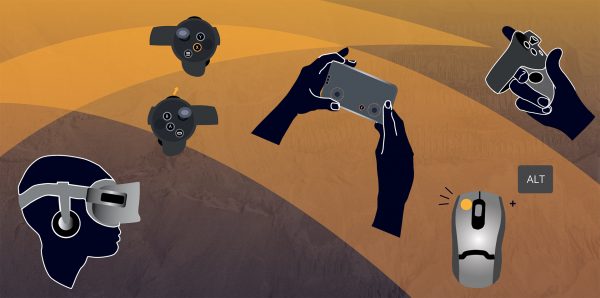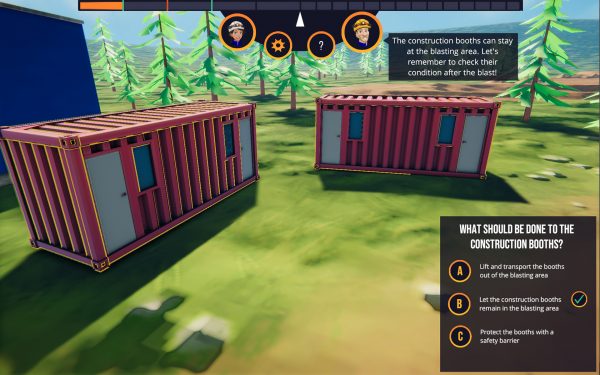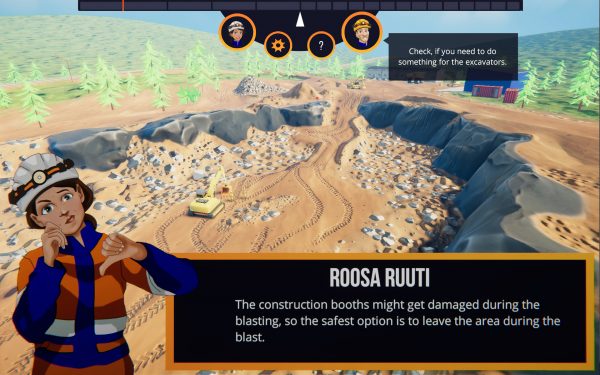
Tuuli Nivala, Master of Education, Project Planner, FrostBit, Lapland University of Applied Sciences
Loru Reinikka, Bachelor of Arts, Project Planner, FrostBit, Lapland University of Applied Sciences
Mining is an old and stable industry with long roots and history. Games, on the other hand, are a newer and constantly growing form of learning. So what kind of role do game design and graphic design have in the digitalization of mining industry both in Finland and internationally?
Mining industry maintaining its relevance in Finland
When looking at recent statistics, we can see mining has persisted as a stable field and provides a great amount of employment in Finland, especially in Lapland (Hokkanen et al. 2020, 47). Finland was ranked tenth on the Investment Attractiveness Index of Fraser-institution survey for a country of potential mineral practice (Yunis & Aliakbari 2020, 9) and has consistently maintained its rank in the global top 10 on the Policy Perception Index for the last nine years. Looking at north Finland, according to the Centre for Economic Development, Transport and the Environment (2020, referenced on 27.09.2021), Lapland alone accounts for more than a third of the turnover for manufacture of metals and a quarter of total turnover of mining in Finland. Through this information we can confidently see mining industry maintaining its relevance in Finland, thus it is important to develop modern solutions for technology and education in the field.
Digital solutions to increase interest in traditional fields
Among many other traditional fields, mining industry focuses mostly on hands-on practical education and does not experience constant rapid leaps in modern innovations in terms of learning. Field practice is perhaps the most efficient way for practical learning, but even in practical fields, theory and know-how concepts are relevant part of the education. In the Migael-project we have tackled on this issue from both perspectives, by creating gamified practices for both hands-on-training and teaching theoretical concepts of the field. So far, the project has established a total of five game exercises and the sixth and last one is in the making. The games focus on different learning concepts and goals either in an open-pit mine or underground mine.
MiGaEL – short for “Mining Game for Education and Learning” – is a project funded by the ELY Center and the European Union Social Fund. The goal of the Migael-project is to create a virtual learning environment ensemble that can be integrated into the actual mining education program of the Lapland UAS. With modern digital solutions like these, not only there can be potential increase in the interest of the traditional field, but also increased international attention. After all, the online world is one of the main pathways for creating global networks and our arctic perspective can be presented globally.
Gamified learning solutions themselves are not a brand-new innovation, but creating learning games which both keep the learner engaged as well as help reaching specific learning goals is not a piece of cake. To establish this, we have paid a specific importance in the game design elements as well as visually pleasing graphics of the exercises that can be played both in Finnish and in English.
The importance of eye-catching and interesting visuals
When making games for the mining industry, the main objective is to let the player experience learning in an interesting, and most of all, understandable way: it is different to look at the walls of an underground mine from the screen of your laptop versus inside of a real mine. But learning what to look and where, for example in a realistic mining environment in VR, is a great way to gather information before actually entering a real mine – or just to see the theory in a more accessible way and in a safe environment. Having the opportunity to get first hand experiences at home about things that usually can be only learned inside of a mine is a great example of the possibilities of digital learning. But how to tell the potential players what the games are about before trying them out?
Graphic design is communicating through visual solutions. The main goal of graphic design in game-making is to help the player understand the information easily with visualization and composition. First glimpse of the game should tell the idea what it is about and what it can give to the one playing it. The biggest challenge to designers is to make educational games look inviting and to emphasize the products’ trustworthy without making it look too institutional. That is why the graphic look in the Migael-project aims for an eye-catching effect but also apprehensible. When the visualization is enjoyable the player can concentrate on learning and exploring the environment.

Picture 1. Graphics play an important role in visual learning
The visual clarity and readability of Migael exercises is made with UI and UX design as a part of the whole graphic look. UI stands for User Interface and means the whole visual look of the game in the parts where the user interacts with the game, for example buttons and menus of the game. UX on the other hand means User Experience and is more than the visual look. UX design is the process designers use to create products that provide purposeful and good experiences to users with the interface of the product. This means that the buttons and other interactable solutions of the game exercises are designed to look nice but also logical to use. When the project looks and works in unified and compelling ways it creates a fluent learning encounter for the player.
Games and 3D simulations as a reliable professional source of information and learning are a relatively recent phenomena, but they are a modern and quite popular and growing way to reach different factors around the globe and share knowledge. While most of the environments in Migael are based on Finnish Lapland scenery, the exercises are globally understandable and usable. The aim of the project is to teach the player correct and safe mining measures but it can also showcase mining education and digital solutions of Finland into other countries. The graphic look is made to be clear and attention-grabbing to assure its reliability and make it be seen as a valid source of information.
Game Design – can everything be gamified?
Some of the learning concepts behind specific Migael game exercises have been significantly more complex than others. The most diverse and difficult learning areas are usually the ones yearning for modern solutions, since they require the most attention and repetition to learn. With the commonly known concept of Digital Game-Based Learning, a gamified solution for such area is often tempting, since it essentially is “learning while doing (playing)”. However, the creation of such learning games is not as simple as making every aspect playable. When wondering if everything could essentially be gamified, it is more relevant to ask specifically what and how.
As hinted, making every learning aspect into something playable and tangible inside a game does not necessarily make it a good learning game. A captivating game is not only clicking and dragging, but includes challenge, feedback and possibly rewards; goals to strive towards. In the fourth Migael game exercise, we created a game for learning safety procedures before and after blasting. When designing the game, it was essential to categorize the procedures which can be made into playable elements, and separate the ones that work better inside the storyline rather than as a playable game action. To create challenge and goals for the game, additionally, we created false game objectives and had the game characters providing feedback for the player, in both right and wrong answers.

Picture 2. Safety measures as game actions
Some of the safety measures were made into direct game actions, as seen in Picture 2. The feedback given by the characters notify about wrong answers as well as clarify the reasoning behind the right answers. The false answers make the game more challenging, so it is not only about finding and completing the measures. In some cases, the player does not only select a right answer, but also gets to play an action in completing the measure: such as moving objects out of the blasting area or closing gates in the right time.

Picture 3. Character feedback on safety measures
However, some of the specific safety measures were not suitable to make into playable game actions. The solution for teaching these aspects inside the game was established by the feedback and monologues given by the game characters, as seen in Picture 3. This does not only solve the problem of gamifying the whole learning area, but creates diversity and depth in the game story.
As for other game exercises in the Migael-project, many different solutions have been made in regards to selecting a specific game type. For example, the fifth exercise was made into a narrated story-game, in which the player listens, observes, takes notes and completes small actions to learn about the concept of drifting in mines. Compared to the fourth exercise, the learning concept for the fifth exercise was too broad to make into a traditional game with hundreds of game actions. This is why gamifying is completely dependent on the specific topic and learning goals.
In conclusion, the whole Migael-project aims to take new steps towards digital education and virtual experiences in a traditional field. Carefully pedagogically planned and visually enriched digital solutions can evoke new interest both nationally and globally, and the project showcases an Arctic view on these types of gamified solutions.
The total cost of the Migael-project is EUR 450,002 of which the Northern Ostrobothnia Center of Economic Development, Transport and the Environment has granted funding from both the European Social Fund (ESF) and the state funding (EUR 337,502). The project’s implementation period is 01/08/2019 – 31/12/2021 by FrostBit Software Laboratory of Lapland University of Applied Sciences.
Read more about the project at: www.migael.fi/en
References
Hokkanen, J., Savikko, H., Koutonen, H., Rannikko, H., Rinne, T. & Pirilä, M. 2020. Suomen mineraaliklusterin kilpailukyky- ja vaikuttavuustutkimus. Helsinki: Valtioneuvoston selvitys- ja tutkimustoiminnan julkaisusarja 2020:15. http://urn.fi/URN:ISBN:978-952-287-940-0
Infographic: Overview: Mining Industry in Finland, 2020. Centre for Economic Development, Transport and the Environment. Referenced on 27.09.2021. https://infogram.com/overview-mining-industry-in-finland-1h7j4djvg0g94nr?live
Yunis, J. & Aliakbari, E. 2020. Fraser Institute Annual Survey of Mining Companies 2020. Referenced on 27.09.2021. https://www.fraserinstitute.org/sites/default/files/annual-survey-of-mining-companies-2020.pdf
Keywords: digital solutions, game design, graphic design, visual learning